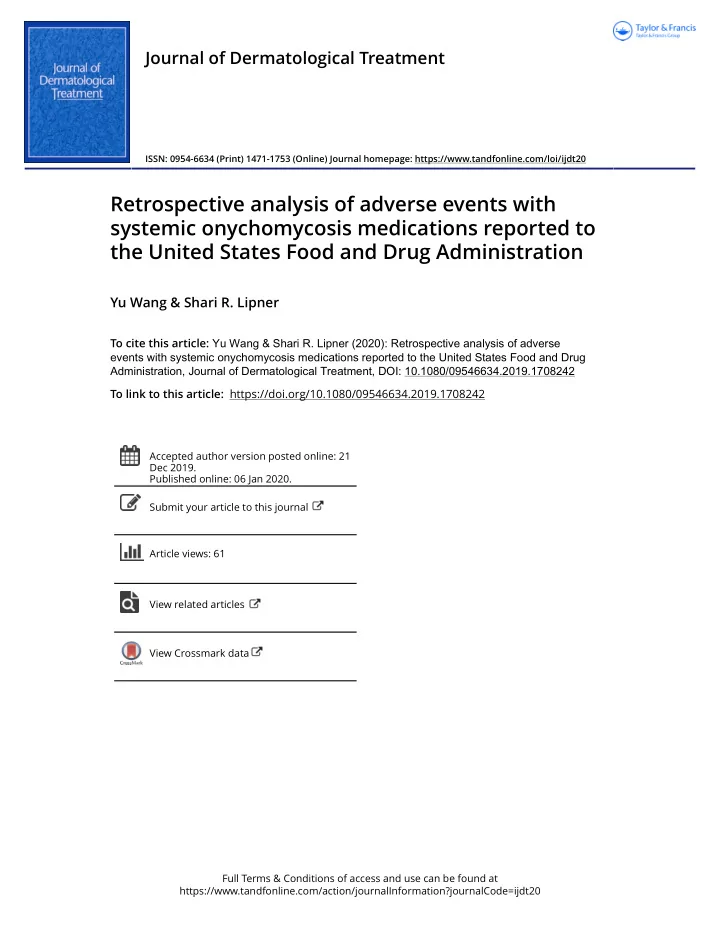

Journal of Dermatological Treatment ISSN: 0954-6634 (Print) 1471-1753 (Online) Journal homepage: https://www.tandfonline.com/loi/ijdt20 Retrospective analysis of adverse events with systemic onychomycosis medications reported to the United States Food and Drug Administration Yu Wang & Shari R. Lipner To cite this article: Yu Wang & Shari R. Lipner (2020): Retrospective analysis of adverse events with systemic onychomycosis medications reported to the United States Food and Drug Administration, Journal of Dermatological Treatment, DOI: 10.1080/09546634.2019.1708242 To link to this article: https://doi.org/10.1080/09546634.2019.1708242 Accepted author version posted online: 21 Dec 2019. Published online: 06 Jan 2020. Submit your article to this journal Article views: 61 View related articles View Crossmark data Full Terms & Conditions of access and use can be found at https://www.tandfonline.com/action/journalInformation?journalCode=ijdt20
JOURNAL OF DERMATOLOGICAL TREATMENT https://doi.org/10.1080/09546634.2019.1708242 ARTICLE Retrospective analysis of adverse events with systemic onychomycosis medications reported to the United States Food and Drug Administration Yu Wang a and Shari R. Lipner b a SUNY Stonybrook Medical School, Stonybrook, NY, USA; b Department of Dermatology, Weill Cornell Medicine, New York, NY, USA ABSTRACT ARTICLE HISTORY Background: Onychomycosis is the most common nail condition and when left untreated, has Received 24 October 2019 Accepted 19 December 2019 esthetic, physical and emotional-social sequelae. Objective: To classify the most common adverse reactions with the oral onychomycosis medications KEYWORDS terbinafine, itraconazole, and off-label fluconazole. Onychomycosis; fungal nail Methods: The United States Food and Drug Administration Adverse Event Reporting (FAERS) database infection; FDA; FAERS; was analyzed for common adverse reactions with terbinafine, itraconazole, and off-label fluconazole. adverse events; liver Transaminase elevations reported with terbinafine usage were further subdivided by the age group. toxicity; terbinafine; Google Trends was used to examine public interest in these medications and compare yearly data fluconazole; itraconazole; with adverse events in the FAERS database. taste disturbance; AST; ALT; Results: The most common adverse reaction with terbinafine was taste disturbance and the most drug interaction; Google; Google Trends common adverse events with itraconazole and fluconazole were drug interactions. Transaminase ele- vations associated with terbinafine were extremely rare in the pediatric population. Increased Google searches for all three medications were also associated with increased reporting of adverse events in the FAERS database. Conclusion: Patients should be counseled that taste disturbance with terbinafine is the most common adverse event. Concomitant medications must be reviewed carefully before prescribing itraconazole or fluconazole since drug interactions are relatively common. Public interest in onychomycosis has increased in recent years, potentially explaining increased prescribing of oral onychomycosis medica- tions and increased reporting to FAERS. Abbreviations: FDA: Federal Drug Administration; FAERS: Federal Drug Administration Adverse Event Reporting System; LFT: Liver Function Test; US: United States Introduction was performed using the Federal Drug Administration Adverse Event Reporting System (FAERS) Database. In FAERS, adverse Onychomycosis is the most common nail condition with a world- events are classified by reaction terms. The 20 most commonly wide prevalence of 5.5%. Appropriate treatment is important to reported reaction terms for each of these medications relieve pain, paresthesias, and improve quality of life (1). The goal were recorded. of onychomycosis treatment is to eliminate the fungal infection To determine the prevalence of aminotransferase abnormal- and restore the nail to its normal state. Therapy is individualized ities in pediatric versus adult populations, increases in AST and based on number or nails affected, nail thickness, nail plate sur- ALT were analyzed by age. face area involved, infecting organism(s), patient co-morbidities, While overall prescribing data for all three of these medica- cost, and patient preferences. Onychomycosis therapies include tions was not available, we sought to compare yearly adverse oral antifungals, topical antifungals, and devices. Overall, oral sys- events in the FAERS database with annual public interest for temic agents are associated with higher mycologic (negative each of the three medications using the Google Trends search potassium hydroxide microscopy and negative culture) and com- terms for terbinafine and Lamisil, fluconazole and Diflucan, and plete cure rates (mycologic cure and a clinically completely nor- itraconazole and Sporanox. Google Trends data were down- mal nail) and have shorter durations of treatment. Systemic loaded from Google (5), analyzed for all available years onychomycosis medications approved by the United States (US) 2004 – 2018, and compared to the yearly numbers of adverse Federal Drug Administration (FDA) are griseofulvin, terbinafine, events reported to the FDA for all three medications. and itraconazole, with the latter two and off-label fluconazole prescribed most frequently (2,3). Therefore, our objectives were to determine the most commonly reported adverse events to the Results US FDA associated with these medications (4). The top 20 most commonly reported adverse events are listed in Table 1. For terbinafine (11,658 cases), ‘ ageusia/dysgeusia ’ Material and methods (1490, 12%), ‘ AST/ALT elevations ’ (762, 6%), and ‘ pruritus ’ (718, A retrospective study of adverse events with terbinafine, itracon- 6%) were most often reported. For itraconazole (9830 cases), azole, and fluconazole from 1 January 1993 to 30 June 2019 ‘ drug interactions ’ (926, 9%), ‘ dermatitis ’ (627, 6%), and ‘ pruritus ’ CONTACT Shari R. Lipner shl9032@med.cornell.edu Department of Dermatology, Weill Cornell Medicine, 1305 York Avenue, New York, NY 10021, USA. � 2020 Taylor & Francis Group, LLC
Recommend
More recommend